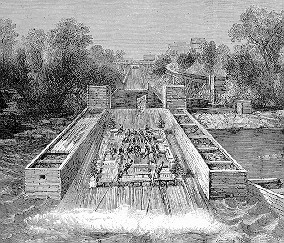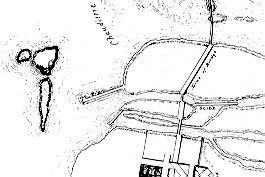 Bronson Slide
Bronson Slide
 Bronson Slide
Bronson Slide
 The metal flume now found off the Bronson channel is on the same site as the crib slide built in
1832 by John Buchanan. Buchanan built his slide in direct competition
from the Wright slide and by eight years later had won over most
of the business from Wright's slide due to its superior location.
The Bronson slide was the most important station on the Ottawa
River. By 1874 all square timber cribs passed through it and
the Hull slide was used for saw logs alone. A crib, or square
timber, is a flat raft of up to 50 logs tied together. The Bronson
slide is sometimes referred to as the South Chaudière or
Victoria Island slide.
The metal flume now found off the Bronson channel is on the same site as the crib slide built in
1832 by John Buchanan. Buchanan built his slide in direct competition
from the Wright slide and by eight years later had won over most
of the business from Wright's slide due to its superior location.
The Bronson slide was the most important station on the Ottawa
River. By 1874 all square timber cribs passed through it and
the Hull slide was used for saw logs alone. A crib, or square
timber, is a flat raft of up to 50 logs tied together. The Bronson
slide is sometimes referred to as the South Chaudière or
Victoria Island slide.
The government revoked the Buchanan's lease on the Chaudière property from Buchanan's widow Mrs. Caroline R. Thomson taking over Bronson slide in 1845 and then bought the Hull slide from Ruggles Wright in 1851. Both were operated by the government and both of the two were sometimes referred to as the government slide in the years after this.
In May 1850 H.Merrill, Superintendent of the Ottawa River Works, reported 300-500 cribs a day passing the Chaudière slides. In 1852, 15,600 cribs had passed through the slides "with 22 rafts still not counted" along with in 1865 200,000 saw logs. All passed through into the retaining boom for use by the many saw mills along the river. Both government slides suffer severely in the fire of April 26, 1900. Extensive repairs were needed after the fire and considerable debris were removed.
 The crib ride was a great Canadian ride and visitors could go
and be entertained by watching the cribs, steered by expert raftsman, go
down the slide. The slide area also provided a magnificent view
of the new Parliament buildings. Edward, Prince of Wales was
given a ride down the crib slide in 1860. The Duke and Duchess
of York went down the slide in 1901. An old photograph shows
how benches were put on the crib for the regal couple and a flotilla
of river boats greeted them at the bottom when they arrived.
Our picture is from The Illustrated London News, October 20
1860 - drawn by G.H. Andrews, and shows His Royal Highness Albert Edward
Prince of Wales descending the timber slide with the members of the
press in a raft following. What looks like a single log plume is
up on the hill to the right of the slide.
The crib ride was a great Canadian ride and visitors could go
and be entertained by watching the cribs, steered by expert raftsman, go
down the slide. The slide area also provided a magnificent view
of the new Parliament buildings. Edward, Prince of Wales was
given a ride down the crib slide in 1860. The Duke and Duchess
of York went down the slide in 1901. An old photograph shows
how benches were put on the crib for the regal couple and a flotilla
of river boats greeted them at the bottom when they arrived.
Our picture is from The Illustrated London News, October 20
1860 - drawn by G.H. Andrews, and shows His Royal Highness Albert Edward
Prince of Wales descending the timber slide with the members of the
press in a raft following. What looks like a single log plume is
up on the hill to the right of the slide.
The best place to view the old slide area and the new metal log flume is through the trees behind the public parking lot in front of buildings 31 and 34 on Victoria Island. It's a nice view of an historic area, but the old slide is totally rotted away. It has been a bit of a garbage dump since the turn of the century (19th) and there is some interesting stuff left lying around there.
The metal log flume that was built over the Buchanan slide was built in 1970 by the Department of Public Works to send pulp wood down to the lower level. It would run for a couple of hours per day. It is still there to look at and the leafy ravine where it is located is quite picturesque. There are some holes in the rock walls where the old crib slide was attached but the original crib slide is completely rotted away and has been for decades.
The workers at Ottawa Hydro Power Plant #2 which is right beside the metal slide sometimes wish they could send any wayward logs which get trapped in their water intake down the metal slide and out of sight and mind, but they are not allowed to and must contract out the disposal of these inconvenient logs and so contribute to cleaning the river.
 There were other log flumes but their location and history are obscure.
In 1826 Colonel By excavated a channel and may have built a single stick slide at the Chaudière.
Levi Young, in 1871 had a board slide on Victoria Island. In
1885 he substituted a tramway for the board slide and this tramway
closed in 1926. This map of 1842 shows an unexpected slide through
what was known as the "Lost Channel". Map by Donald Kennedy.
Lithographed by Willis and Probts, New York, 1842. Russell Island
is shown in three parts. The various booms and walls were
made to guide the rafts away from the falls but also as power
channel to keep the water level up as it entered the mills during
dry summers.
There were other log flumes but their location and history are obscure.
In 1826 Colonel By excavated a channel and may have built a single stick slide at the Chaudière.
Levi Young, in 1871 had a board slide on Victoria Island. In
1885 he substituted a tramway for the board slide and this tramway
closed in 1926. This map of 1842 shows an unexpected slide through
what was known as the "Lost Channel". Map by Donald Kennedy.
Lithographed by Willis and Probts, New York, 1842. Russell Island
is shown in three parts. The various booms and walls were
made to guide the rafts away from the falls but also as power
channel to keep the water level up as it entered the mills during
dry summers.
 Water Channels and Plumes
Water Channels and Plumes
 10 -- Bronson Channel
10 -- Bronson Channel
 11 -- O.H.E.C Channel
11 -- O.H.E.C Channel
 12 -- Buchanan Channel
12 -- Buchanan Channel
The Bronson Channel (10) feeds the Ottawa Hydro Power Plant #2, (32) which is at its far end, and was also the entrance for the Victoria Island crib slide (27). When the channel is occasionally emptied for repairs in the summer and at the bottom one can see what looks like a wood planked covered corridor dug into the bottom of the channel and leading to the hydro plant. This covered corridor is likely an engineering artifact which improves the water head to the hydro turbines. There is a flat stone covered ramp leading to the slide entrance. After the building of the ring dam, the water level rose up there was a kind of lock built to allow the slide to operate but I can not find any trace of that.
The OHEC Channel (11) feeds the The Ottawa Hydro Power House #4 (33) via a flume covered by a concrete roof. The flume and its cover is visible from the sidewalk. In the middle of this channel, just beside the E.B. Engineering offices, was a quaintly named Coffin Island. The Buchanan Channel (12) used to feed the waterworks of the Booth Groundwood Pulp Mill #1 (03), the brick building just across the street, as well as some earlier mill set up by there by Buchanan maybe decades before the fire.
